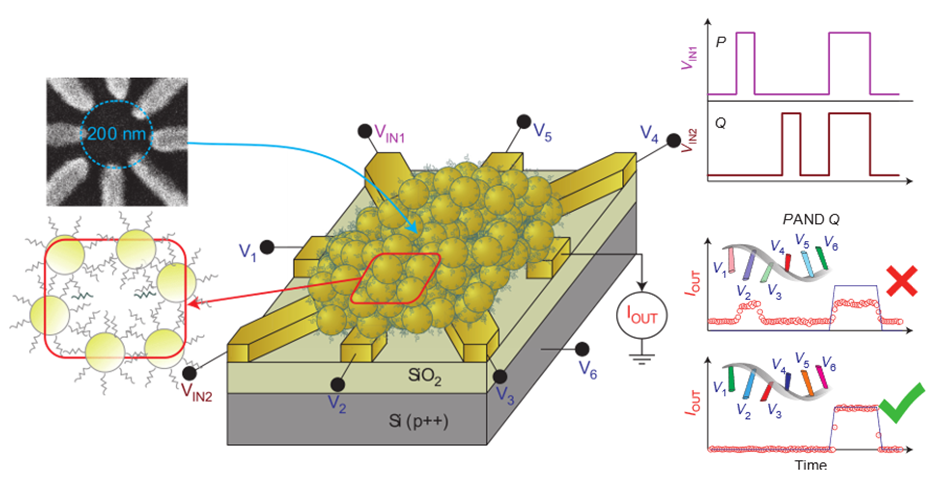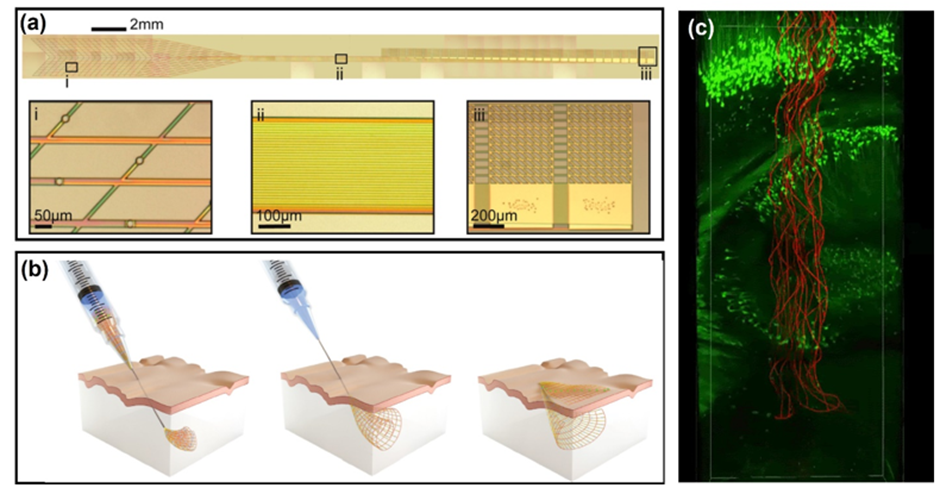Brain-inspired electronics
Brain-inspired computing is a growing and interdisciplinary area of research that investigates how the computational principles of the biological brain can be translated into hardware design to achieve improved energy efficiency.
Brain-inspired electronics encompasses various subfields, including electronic circuitry for neuromorphic and in-memory computing, that have been shown to outperform traditional digital hardware in executing cognitive tasks. With the rising demand for more powerful yet energy-efficient hardware for large-scale artificial neural networks, brain-inspired electronics is emerging as a promising solution for enabling energy-efficient computing and expanding AI to the edge.

As founding member of the Center for Brain-Inspired Nano Systems (BRAINS), our team’s mission is to develop efficient nanoelectronic hardware for information processing. We combine core expertise in nanoelectronics with expertise from computer science, applied mathematics, artificial intelligence, and neuroscience, to lay the scientific foundations for a new generation of powerful, energy-efficient computing hardware. Artificial and biological neural networks, in particular the brain, form a main inspiration. It is our ambition to understand the key features underlying the functioning of the brain and translate those into electronic devices and circuits. Our research focuses on reconfigurable, disordered nanomaterial networks, in particular dopant network processing units (DNPUs) and hybrid organic-inorganic nanoparticle networks. We also work on hardware to interface biological neural networks and our unconventional computing electronics. Our research has a fundamental character with a keen eye for technological applications.
- Self-Assembly of Hybrid Nanostructures for Neuromorphic Electronics

Figure: Schematic representation of a nanoparticle network (NP) device and its working principle. Adapted from Bose and Lawerence et al., Nat. Nanotechnol. 10, 1048 (2015). Left: Au NP network with 1-octanethiols as tunnel barriers between the NPs. The size of each NP is approximately 20 nm. Five of the eight Ti/Au electrodes (V1-V5), together with the back-gate V6, are used as control voltages to tune the NP network. A genetic algorithm is used to find suitable configurations in the parameter space. The remaining three electrodes carry the time-varying input and output signals. Right: Example of using the NP network to mimic an AND gate by varying the control voltages until the output waveform matches the ideal reference waveform.
Project Description: In the search of ever more energy-efficient electronics, especially for machine-learning applications, researchers have taken inspiration from (self-assembled) systems in biology, like the brain. In contrast to regular computers, which are designed with a top-down approach where the exact behavior and layout of the circuits is precisely defined, the brain is a self-organizing system which is capable of reconfiguring itself to adapt to changes. To implement some of these concepts, researchers use various concepts like molecular self-assembly and hybrid nanostructures made from both organic and inorganic molecules which can be coupled with regular electronics.
In our previous work [1], we have shown that disordered networks of functionalized nanoparticles (NPs) can be configured to behave like Boolean logic gates and classifiers. The functionalized NPs act as single-electron transistors, i.e., strongly nonlinear periodic switches, while the organic ligands act as tunnel barriers. The purpose of this research project is to build on these results and enhance the functionality by introducing various novel organic ligands and magnetic nanoparticles to enhance the addressability and to introduce memory to tackle new time-dependent problems. By directly connecting chemical synthesis, physical experiment, and simulation of data-driven and physical models, the project will explore the development of intelligent matter based on Material Learning.
References:
[1] S. K. Bose, C. P. Lawrence, Z. Liu, K. S. Makarenko, R. M. J. van Damme, H. J. Broersma und W. G. van der Wiel, „Evolution of a designless nanoparticle network into reconfigurable Boolean logic,“ Nature Nanotechnology, Bd. 10, p. 1048–1052, 2015.Funding
Collaborative Research Center 1459: Intelligent MatterInterested?
This project is in close collaboration with the University of Münster. Are you interested in designing, fabricating, and measuring hybrid nanomaterial networks for brain-inspired electronics, please do not hesitate to contact us:- Marc Beuel (m.beuel@utwente.nl)
- Wilfred van der Wiel (w.g.vanderwiel@utwente.nl)

- Brain-inspired Hardware Acceleration of Neural Networks

Figure: Schematic of a dopant network processing unit (DNPU). Electrodes are deposited on a silicon wafer, partly doped via ion implantation. Part of the surface of the chip is etched away to make sure the proper dopant concentration is reached. The radius of the active area between the electrodes is typically around 250 nm. From T. Chen et al., Nature 577, 341-345 (2020).
Project Description: Recently we have shown that dopant network processing units (DNPUs) can be trained to perform complex operations on a very small silicon chip [1,2]. The device can be trained such that it is able to perform various classification tasks in a single step, making it fundamentally different from digital computers.
We aim to further explore this route and improve on the device as it is today. The aim is to expand the operating regime to conditions more suitable for everyday life. This means that the device should be able to operate consistently at room temperature and that multiple devices should be able to communicate with one another.
Furthermore, we explore new materials and physics to improve the functionality of the device. We seek to implement memory into the devices, to radically improve its energy-efficiency and upscale potential. Together with our partners embedded in the European Innovation Council Pathfinder project HYBRAIN we combine our expertise to achieve this goal. With our collaborators at the University of Münster in the Collaborative Research Center 1459: Intelligent Matter, interactions with light-based systems are explored to realize fully in-hardware edge computing demonstrations.
References:
[1]: T. Chen, J. van Gelder, B. van de Ven, S. Amitonov, B. de Wilde, H.-C. Ruiz-Euler,
H. J. Broersma, P. A. Bobbert, F. A. Zwanenburg, W. G. van der Wiel, “Classification with a disordered dopant-atom network.”, Nature 577, 341-345 (2020).[2]: Hans-Christian Ruiz Euler, Marcus N. Boon, Jochem T. Wildeboer, Bram van de Ven, Tao Chen, Hajo Broersma, Peter A. Bobbert and Wilfred G. van der Wiel, “A deep-learning approach to realizing functionality in nanoelectronic devices.”, Nature Nanotechnology 15, 992-998 (2020).
Funding
HYBRAIN, Collaborative Research Center 1459: Intelligent MatterInterested?
This project is in close collaboration with the University of Münster and part of the EU project HYBRAIN. Are you interested in designing, fabricating, and measuring semiconductor nanostructures for brain-inspired electronics, please do not hesitate to contact us:- Lorenzo Cassola (l.cassola@utwente.nl)
- Reinier Cool (r.j.c.cool@utwente.nl)
- Wilfred van der Wiel (w.g.vanderwiel@utwente.nl)


- Energy-efficient hardware for autonomous driving systems

Figure: Non-linear classification using a dopant network processing unit (DNPU). DNPUs can be trained for feature extraction (a) or non-linear high-dimensional projection of input data, which can be scaled up into image classification tasks. From T. Chen et al., Nature 577, 341-345 (2020).
Project Description: Brain-inspired computing is a growing and interdisciplinary area of research investigating how the computational principles of the biological brain can be translated into hardware design to achieve improved energy efficiency. Brain-inspired computing encompasses various subfields, including neuromorphic and in-memory computing, that have been shown to outperform traditional digital hardware in executing cognitive tasks. With the rising demand for more powerful yet energy-efficient hardware for large-scale artificial neural networks, brain-inspired computing is emerging as a promising solution for enabling energy-efficient computing and expanding AI to the edge.
Our research focus is to develop new in-materia computing frameworks based on nano-scale dopant network processing units [1]. These recently developed tunable non-linear devices have several electrodes that are used to feed the inputs and tune the desired functionality [2].
One particularly interesting functionality of these devices is the capability of solving non-linearly separable tasks, such as exclusive OR (XOR). XOR can also be solved with a neural network with one hidden layer requiring up to nine operations. Therefore, a single nano-scale device mimics a fully-connected neural network with one hidden layer. This is a great source of motivation toward scaling up [3] the devices into networks of devices to realize large-scale neural networks in hardware [4].
References:
[1] T. Chen, J. van Gelder, B. van de Ven, S. Amitonov, B. de Wilde, H.-C. Ruiz-Euler,
H. J. Broersma, P. A. Bobbert, F. A. Zwanenburg, W. G. van der Wiel, “Classification with a disordered dopant-atom network.”, Nature 577, 341-345 (2020).[2] Hans-Christian Ruiz Euler, Marcus N. Boon, Jochem T. Wildeboer, Bram van de Ven, Tao Chen, Hajo Broersma, Peter A. Bobbert and Wilfred G. van der Wiel, “A deep-learning approach to realizing functionality in nanoelectronic devices.”, Nat. Nanotechnol. 15, 992-998 (2020).
[3] Hans-Christian Ruiz Euler, Unai Alegre-Ibarra, Bram van de Ven, Hajo Broersma, Peter A. Bobbert, “Dopant Network Processing Units: Towards Efficient Neural-network Emulators with High-capacity Nanoelectronic Nodes”, Wilfred G. van der Wiel, Neuromorph. Comput. Eng. 1, 024002 (2021).
[4] B. van de Ven, U. Alegre-Ibarra, P. J. Lemieszczuk, P. A. Bobbert, H.-C. Ruiz Euler, W. G. van der Wiel, “Dopant network processing units as tuneable extreme learning machines”, Front. Nanotechnol. 5, 1055527 (2023).
Funding
Toyota Motor Europe (TME), The Dutch Research Council (NWO)Interested?
This project is in close collaboration with Toyota Motor Europe and part of the NWO HTSM project Nanomaterial Networks for Artificial Intelligence in the Automotive Industry: NANO(AI)2. Are you interested in combining device physics, electrical engineering and machine learning, please do not hesitate to contact us:- Mohamadreza Zolfagharinejad (m.zolfagharinejad@utwente.nl)
- Wilfred van der Wiel (w.g.vanderwiel@utwente.nl)

- Flexible brain-computer interfaces

Figure: (a) Optical microscopy image of a syringe-injectable ultra-flexible mesh electronics probe containing (i) Pt- recording electrodes, (ii) the stem region containing independent metal interconnects for each Pt- electrode, and (iii) the input/output (I/O) pads for individually addressable Pt- electrodes (adapted from [1]). (b) Schematic describing the syringe injection method, enabling seamless integration of recording/stimulation electrodes in a minimally invasive manner (adapted from [2]). (c) Confocal fluorescence microscopy image of the brain tissue containing the mesh electronics platform. The open mesh structure prevents or eliminates the chronic immune response and enables seamless integration of recording/stimulation electrodes (adapted from [3]).
Project Description: We are working towards developing flexible brain-computer interfaces (BCIs) that can be delivered to distinct brain regions via syringe-injection (see figure (a)-(b)) [1-2]. This enables seamless integration of the electronics with the brain tissue and allow long-term stable monitoring and modulation of neural activity (see figure (c)) [3]. We are focusing on (1) understanding the diverse dynamics and emergent behavior of the neural circuitries and (2) treatment of neurological and neurodegenerative disorders including Alzheimer’s and epilepsy.
References:
[1] Nano Letters, 2017, 17, 5836-5842 (link)[2] Nature Nanotechnology, 2015, 10, 629-636 (link)
[3] Nature Materials, 2019, 18, 510-517 (link)
Funding
BRAINS Center for Brain-Inspired Nano SystemsInterested?
This project is in close collaboration with the Radboud Universiteit Nijmegen. Are you interested in combining device physics, electrical engineering and neuroscience, please do not hesitate to contact us:- Emre Mulazimoglu (e.mulazimoglu@utwente.nl)
- Ogeday Cicek (m.o.cicek@utwente.nl)
- Wilfred van der Wiel (w.g.vanderwiel@utwente.nl)


